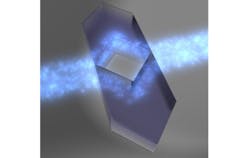Invisibility cloaks are much easier to create for diffusive environments
Macroscopic invisibility cloaks have turned out to be fundamentally difficult to design; however, large cloaks are easier to create if the atmosphere they operate in is diffusive, according to researchers at the Public University of Navarre (NUP/UPNA; Pamplona, Spain) and the Universitat Politècnica de València (UPV; València, Spain).
The group has come up with a novel invisibility cloak capable of concealing objects in diffusive atmospheres, and not just for continuous-wave (CW) light, as in the cloaks developed so far, but also for pulsed light.1 Their work, has the potential to minimize the perceived presence of, for example, an airplane in fog or an oceangoing submarine.
"It has recently been shown that [the difficulty of designing a large invisibility cloak] disappears if the object one is intending to conceal is in a diffusive environment," says Alejandro Martínez-Abiétar, a researcher at UPV's Centre for Nanophotonic Technology. "In this case, and unlike in nondiffusive atmospheres, it is possible to build, in a fairly straightforward way, invisibility cloaks of a macroscopic size that work for any light direction and on a high bandwidth. However, the cloaks proposed so far do not work properly when the object is illuminated by short light pulses, essential in a large number of applications."
Solution for pulsed light
The new cloaks devised by the UPV and NUP-UPNA researchers solve this problem by taking a transformation-optics approach that enables one to know which material is best suited to creating the cloak and concealing the object. The resulting cloak, which is based on a layered stack of isotropic materials, was numerically verified by the researchers (isotropic materials are vastly easier to create and manipulate than the anisotropic materials that some invisibility cloaks are based on).
The cloaks have several applications that cannot be tackled using any previous design. “Apart from the ones already mentioned, they would render invisible objects susceptible to causing interference in communication systems and in image tomography systems in which work is often done with diffusive mediums such as organic tissue,” says Miguel Beruete, a researcher at NUP.
The NUP-UPNA and UPV researchers will soon be working to build an experimental invisibility cloak for use in diffusive atmospheres.
Source: http://www.alphagalileo.org/ViewItem.aspx?ItemId=171795&CultureCode=en
REFERENCE:
1. B. Orazbayev et al., Phys. Rev. A 94, 22 December 2016; https://doi.org/10.1103/PhysRevA.94.063850
About the Author
John Wallace
Senior Technical Editor (1998-2022)
John Wallace was with Laser Focus World for nearly 25 years, retiring in late June 2022. He obtained a bachelor's degree in mechanical engineering and physics at Rutgers University and a master's in optical engineering at the University of Rochester. Before becoming an editor, John worked as an engineer at RCA, Exxon, Eastman Kodak, and GCA Corporation.

